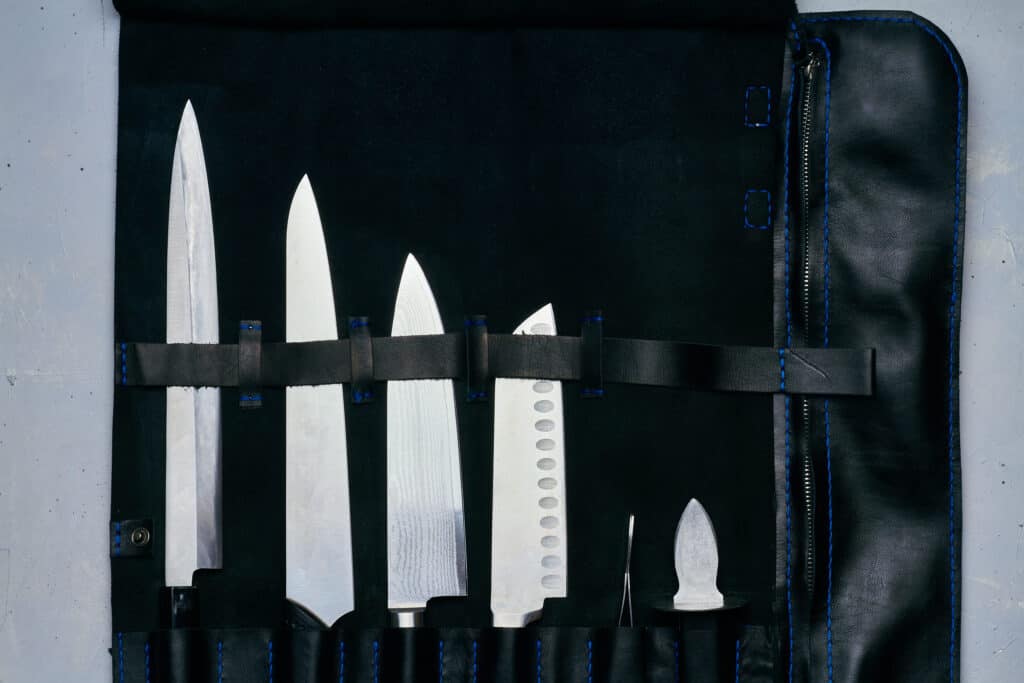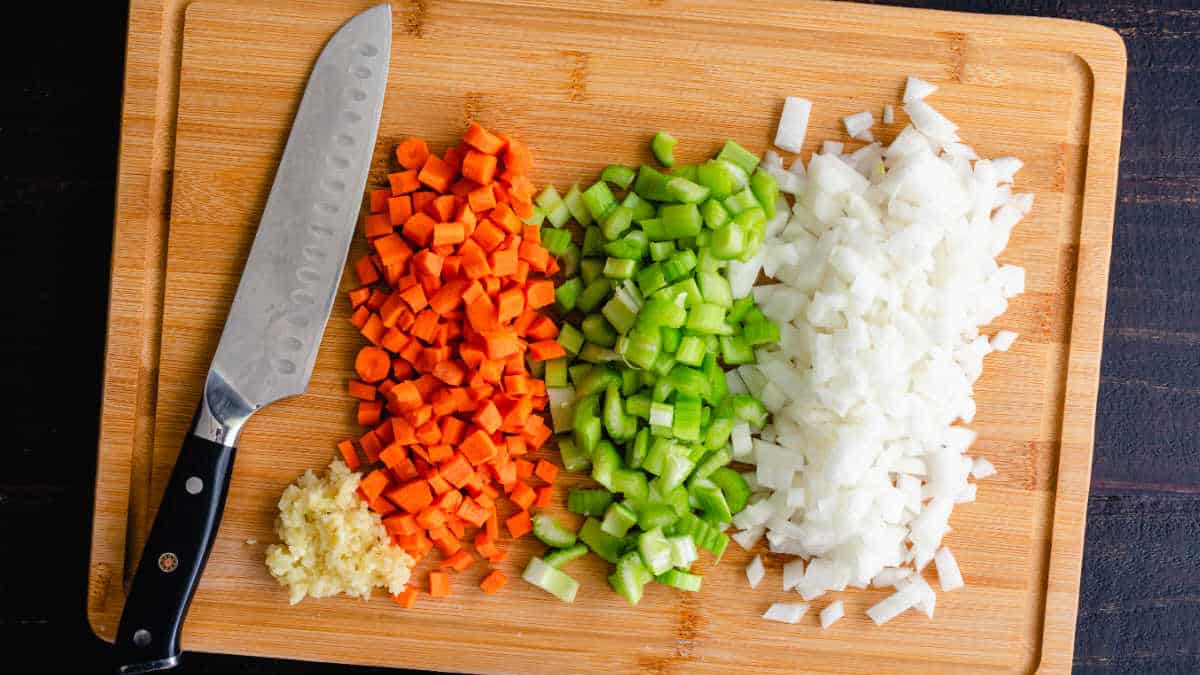When you visit a merchant by clicking a link on this site we may make a commission on anything you buy (at no additional cost to you). Affiliate programs and affiliations include, but are not limited to Amazon Associates and the eBay Partner Network.”
A Santoku knife is a versatile Japanese kitchen tool celebrated for its unique design and functionality. Known as the “three virtues” knife, the Santoku excels in preparing meat, fish, and vegetables while mastering the three essential knife techniques: chopping, slicing, and dicing. The popularity of this knife is attributed to its ability to cover a wide range of tasks and maintain precision in each cut.
While the Santoku knife may resemble a Western chef’s knife at first glance, it features a uniquely shorter, flatter blade with a slight upward curve near the tip. This design difference signifies that the Santoku should be used with distinct techniques compared to a traditional chef’s knife. Most users find that the Santoku knife, with its ergonomic grip and balanced weight, offers greater control and adaptability, making it the go-to tool for culinary enthusiasts and professional chefs alike.
Understanding when to use a Santoku knife can significantly enhance your kitchen experience and produce better results in your cooking. Mastering the proper techniques in handling this Japanese knife will improve your slicing skills and overall efficiency in the kitchen. Whether it’s slicing paper-thin vegetables, creating uniform meat cuts, or finely dicing ingredients, the Santoku knife can undoubtedly take your culinary skills to the next level.
Origins of Santoku Knife
Traditional Japanese Knives
In Japan, there is a long history of creating specialized knives for various culinary tasks. Traditional Japanese knives are known for their precision, craftsmanship, and sharpness. They are typically made from high-quality materials such as carbon steel, high-carbon steel, and Damascus steel. Some of the most popular traditional Japanese knives include the Yanagiba, Deba, and Usuba.
Evolution of Santoku Knife
The Santoku knife, originating from Japan, was first introduced in the years following World War 2 as an alternative to the traditional vegetable cleaver found in many Japanese kitchens at that time. The Santoku knife, which translates to “three virtues” or “three uses,” was designed to be a versatile, all-purpose kitchen tool capable of slicing fish, cutting meat, and chopping vegetables with ease. Today, the Santoku has gained popularity beyond Japan and is widely used by professional chefs and home cooks worldwide for its versatile nature and ultra-sharp blade.
Carbon and Stainless Steel Types
When it comes to Santoku knives, both carbon and stainless steel blades are popular choices. Carbon steel Santoku knives are known for their exceptional sharpness and precise cutting abilities. However, since carbon steel is prone to rust and discoloration, it requires more maintenance and care compared to stainless steel knives.
Stainless steel Santoku knives, on the other hand, are more resistant to rust, staining, and corrosion, making them easier to maintain. While they may not be as sharp as carbon steel blades, advancements in manufacturing technology have allowed for the production of high-quality stainless steel Santoku knives that still offer impressive cutting abilities. Some stainless steel Santoku knives also incorporate high carbon content or Damascus steel, resulting in a perfect balance between sharpness and durability.
In summary, the Santoku knife has its roots in traditional Japanese knife-making and has evolved to become a versatile and essential kitchen tool for food preparation. Both carbon and stainless steel Santoku knives offer unique benefits, catering to the preferences and needs of chefs and home cooks alike.
Anatomy of a Santoku Knife

Blade Shape and Length
The Santoku knife is characterized by its boxy blade, which features a slightly curved edge and a spine that rounds down to a blunt tip. This unique shape is referred to as “sheepsfoot.” Commonly, the blade length ranges between 5 and 7 inches, offering a versatile size for various cutting tasks (Allrecipes).
Handle Materials and Design
Santoku knives can have handles made from various materials, such as wood, plastic, or stainless steel. The design may differ as well, with some featuring a traditional Japanese handle (known as Wa handle) or a western-style handle. One key feature is that the handle must provide a comfortable grip for extended use, ensuring better control and balance during cutting, slicing, and chopping.
Sharpness and Bevel Types
Santoku knives are known for their sharpness, which is a result of the high carbon steel used in their construction. They come in different bevel types, such as single bevel or double bevel. A single bevel Santoku knife has only one side of the blade sharpened, while a double bevel features both sides of the blade with an edge. Double bevel Santoku knives are more common and offer precise cutting and ease of use for both right and left-handed users. The degree of sharpness, as well as the type of bevel, can affect the performance of the knife during tasks like slicing fish, cutting meat, and chopping vegetables (CulinaryLore).
Applications of a Santoku Knife
The Santoku knife was originally invented for Japanese homemakers as an all-purpose tool, primarily intended for slicing fish, cutting meat, and chopping vegetables. It is a versatile tool that can handle various kitchen tasks with ease. Let’s explore some specific techniques and uses for this versatile knife.
Meat Cutting Techniques

The Santoku knife excels in cutting large pieces of meat, like poultry and fish. Its sharp blade allows for clean, precise cuts and eliminates the need for sawing back and forth. It is especially suited for slicing thin pieces of meat, without crushing or tearing the flesh. However, it’s essential to avoid using it on bones, as the blade may chip.1
Vegetable and Fruit Preparation
The Santoku knife’s unique blade shape enables effortless vegetable and fruit preparation. Thanks to its tapered, thin blade, it can easily slice through hard and soft produce alike. The knife’s flat edge makes it perfect for vertical chopping, allowing for quick and precise food preparation. It can slice through tomatoes, peel and trim fruits, or segment citrus with ease.
Chopping, Dicing, and Mincing
When it comes to chopping, dicing, and mincing, the Santoku knife is unparalleled. Its wide, flat blade lets you chop and dice vegetables and fruits with precision. To mince herbs, the Santoku knife’s sharp edge and broad surface provide the perfect combination of control and cutting performance. The flat blade also makes it easy to transfer chopped ingredients from the cutting board to the pan, making your cooking process more efficient.
In conclusion, the Santoku knife is a versatile and practical addition to any kitchen. Its unique design and sharp blade allow for precise cutting, slicing, and chopping of various types of food, making it a reliable tool for both experienced chefs and home cooks. Make sure to use the Santoku knife responsibly and maintain its sharpness to fully enjoy its benefits.
Benefits and Advantages
Efficient and Precise Cutting
A Santoku knife offers an efficient and precise cutting experience due to its thin blade and specialized edge design. The knife’s thin blade allows for accurate slicing, dicing and chopping, making it ideal for cutting meat, fish, and vegetables with ease. Some Santoku knives also feature a granton edge, which has small indentations on the blade that prevent food from sticking and create air pockets for smoother cutting. The flat cutting edge and slightly pointed tip of the Santoku make it particularly helpful for slicing cheese, fruits, and effortlessly mincing herbs. When using a Santoku knife, the cutting motion involves a more straightforward up and down movement, contributing to a more efficient cutting experience.
Versatility in the Kitchen
One of the key advantages of a Santoku knife is its versatility in the kitchen. It serves as an all-purpose knife that can perform various tasks, making it a valuable addition to any knife set. The Santoku excels at tasks such as filleting, dicing, and even functions like scooping food thanks to its wide and flat blade shape. This broad range of uses and the ability to perform well in most cutting situations make it a reliable tool in both professional and home kitchens.
Comfort and Control
Santoku knives provide an impressive level of comfort and control for users. The knives are designed to accommodate cooks with different hand sizes and grip preferences, allowing for a more comfortable and precise cutting experience. When compared to a traditional chef’s knife or gyuto, the Santoku is often lighter and more maneuverable, making it ideal for those who feel more comfortable with a smaller and more compact knife. Some hybrid Santoku knives even combine the best features of both a Santoku and a chef’s knife, maximizing efficiency and ease of use for cooks at all skill levels.
In summary, the benefits of using a Santoku knife in your kitchen include efficient and precise cutting, versatility in various tasks, and enhanced comfort and control while cooking. This unique kitchen tool can make a significant difference in your overall cooking experience and become a staple in your knife collection.
Maintenance and Sharpening
Regular maintenance is vital to ensure the reliability and performance of your Santoku knife. Proper sharpening can enhance its precision cutting abilities while prolonging the life of the blade.
Honing Techniques
Honing your Santoku knife is essential in maintaining its sharpness. It is recommended to hone the blade regularly, before or after each use. The honing process aligns the blade’s edge, allowing for better cutting performance. To hone your Santoku knife, hold it at a 20-degree angle while gliding it along a honing rod, making sure to cover its entire length.
Whetstone Usage
Sharpening your Santoku knife with a whetstone is another effective technique. Begin by soaking your whetstone in water for 20 minutes to eliminate air bubbles and allow for smooth sharpening. Lay the knife at a 45-degree angle to the stone with the blade facing you. Use consistent strokes and even pressure throughout the process, and remember to sharpen both sides of the blade if it’s a double-beveled knife. Switch to the finer side of the whetstone when you’re done, and repeat the process to achieve the desired sharpness.
Stropping and Polishing
Stropping is the final step in maintaining the sharpness of your Santoku knife. It helps to remove any burrs and polishes the edge of the blade. To strop your knife, use a leather strop or a stropping compound and smoothly glide the blade along the surface, keeping its angle consistent.
To summarize, proper maintenance of your Santoku knife includes honing, using a whetstone for sharpening, and stropping to polish the blade. When cared for correctly, it can serve both home cooks and professional chefs effectively, providing improved control and precision in cutting, slicing, and chopping tasks. The lightweight design and ergonomic handle materials contribute to its ease of use, making it a versatile tool in any kitchen.
Do Sheepsfoot Blades Have A Purpose? (Cuz They’re Ugly…)
Spetsnaz Machetes – Blades Of The Russian Special Forces
What Is The Actual Purpose Of A Spear Point Knife Blade?
CRKT CEO Review – Coolest, Most Worthless Knife Ever?
How Sharp Is A Scalpel? (Is It Sharper Than A Razor?)
Can You Shave With A Knife? (Yes, Here’s How)
When you visit a merchant by clicking a link on this site we may make a commission on anything you buy (at no additional cost to you). Affiliate programs and affiliations include, but are not limited to Amazon Associates and the eBay Partner Network.”







